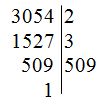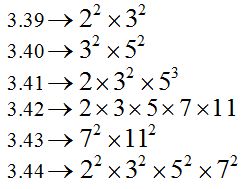HOW TO SAVE TIME WHEN TRYING TO FIND OUT IF A NUMBER IS PRIME OR NOT
a) If we do it manually dividing with high prime numbers, we will stop every time the quotient is smaller than the denominator.
Example:
3.38 We will break down the number 3054 into its prime factors:

Since I see that 509 is not divisible by 2, 3, 5, 7, 11, I try to divide it by 13, 17, 19, 23: 

In each division above, we can see that the quotient is always higher than the denominator. In this case, we have to keep trying with even higher prime numbers as denominators until the quotient is lower than the number in this place. If the remainder is not zero, we can well say that the number we have in the dividend is a prime number.


We can see that the quotient 22 is lower than the denominator 23 and that the remainder is different from zero. We can say that 509 is a prime number.

b) Another way of making the task of knowing if a number is a prime number simpler is by using our Calculating Sheet. The results of the exercises are instantaneous and if the result has decimal points, you try with the next prime number.
c) If you have internet, you can search GOOGLE. You write: how to know if a number is prime.
3.39 Break down 36 into its prime factors:
3.40 Break down 225 into its prime factors:
3.41 Break down 22502 into its prime factors:
3.42 Break down 2310 into its prime factors:
3.43 Break down 5929 into its prime factors:
3.44 Break down 44100 into its prime factors:
Answers:


